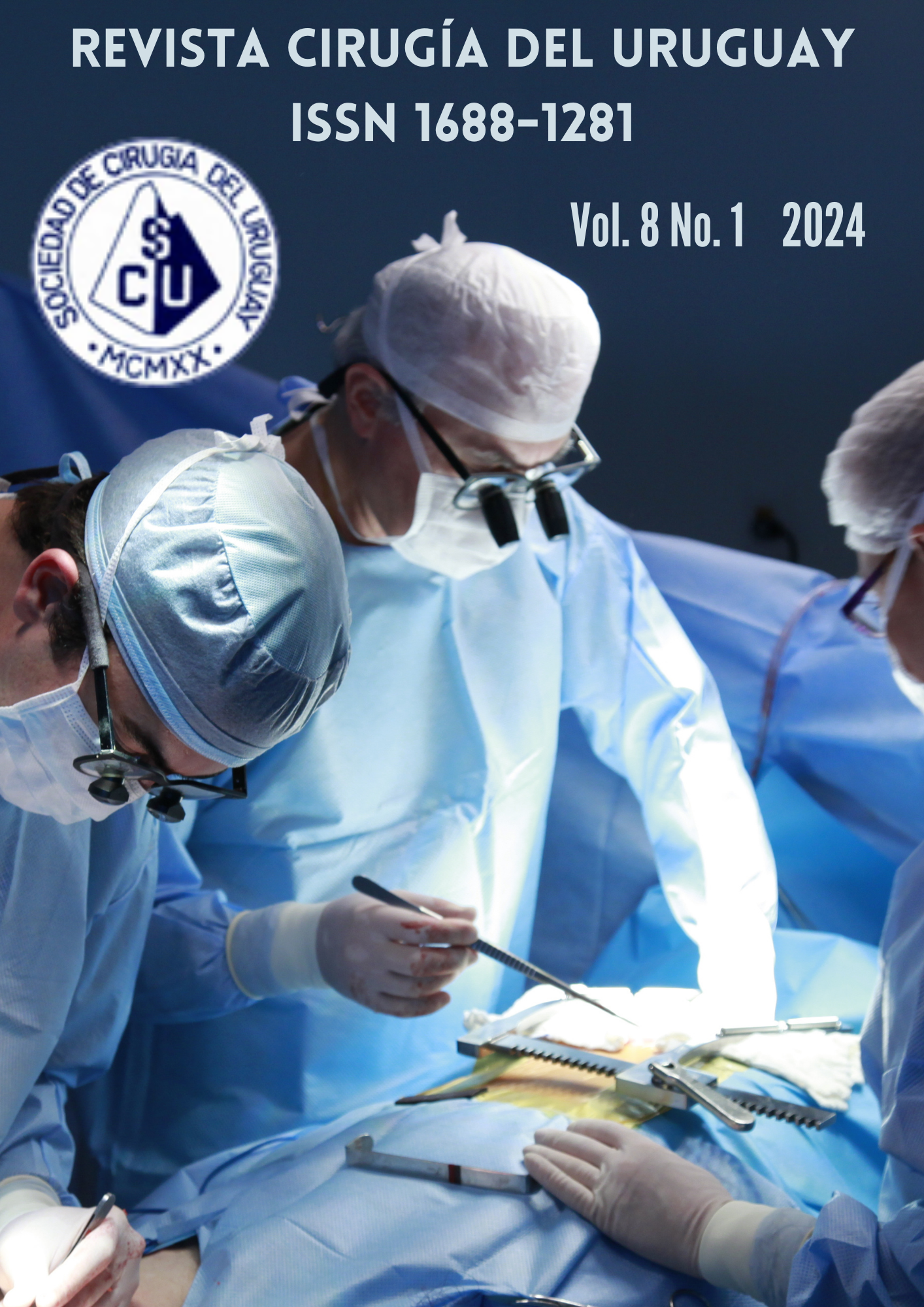Hepatic mucinous cystic neoplasm, case report and pathology analysis
DOI:
https://doi.org/10.31837/cir.urug/8.1.1Keywords:
Hepatic cystadenoma, hepatic mucinous cystic neoplasmAbstract
Since the early reports in the literature, the nomenclature of hepatobiliary cystic lesions has been modified, with two types of lesions being described: serous and mucinous. In 2010, the World Health Organization established a new classification in which the terms hepatobiliary cystadenomas and cystadenocarcinomas were replaced by more specific entities such as mucinous cystic neoplasms and intraductal cystic tumors (intraductal papillary neoplasm, intraductal tubulopapillary neoplasm, and intraductal oncocytic papillary neoplasm). Regarding mucinous cystic neoplasms, the presence of ovarian stroma confers distinctive pathological and biological characteristics, which is a requirement in the WHO classification. This characteristic differentiates it from biliary hamartomas, congenital cysts, and Caroli's disease. Such neoplasms are rare, with an incidence of less than 5% of hepatic cystic lesions, and occur almost exclusively in women, often perimenopausal. Their potential for malignancy has been described, and this is the indication for surgical resection treatment. We present a clinical case of a patient with a mucinous cystic hepatic neoplasm, classified as a hepatic cystadenoma according to the old classification
Downloads
Metrics
References
Mezale D, Strumfa I, Vanags A, Bahs G, Strumfs B, Silovs A, et al. Mucinous Cystic Neoplasms of the Liver and Extrahepatic Biliary Tract. In: Topics in the Surgery of the Biliary Tree. InTech; 2018.doi: 10.5772/intechopen.77118
Jwa E-K, Hwang S. Clinicopathological features and post-resection outcomes of biliary cystadenoma and cystadenocarcinoma of the liver. Ann HepatobilPancreat Surg. 2017;21(3):107.doi: 10.14701/ahbps.2017.21.3.107
Averbukh LD, Wu DC, ChoWC, Wu GY. Biliary Mucinous Cystadenoma: A Review of the Literature. J ClinTransl Hepatol. 2019;7(2):149-153.doi: 10.14218/JCTH.2019.00017
Yoon MH, Yoon JW, Han BH. Mucinous cystadenoma of the liver with ovarian-like stroma: the need for complete resection. J Korean Surg Soc. 2011;81(Suppl 1).doi: 10.4174/jkss.2011.81.Suppl1.S51
Chen YW, Li CH, Liu Z, Dong JH, Zhang WZ, Jiang K. Surgical management of biliary cystadenoma and cystadenocarcinoma of the liver. Genet Mol Res. 2014;13(3):6383-90.doi: 10.4238/2014.August.25.1
Martínez-González J, Aicart-Ramos M, Moreira Vicente V. Cistoadenoma hepático. Med Clin (Barc). 2013;140(11):520-2.
Ferraguti DA, McGetrick M, Zendejas I, Hernandez-Gonzalo D, Gonzalez-Peralta R. Mucinouscystadenoma: A rare hepatic tumor in a child. Front Pediatr. 2017;5:215. doi: 10.3389/fped.2017.00215.
Vogt DP, Henderson JM, Chmielewski E. Cystadenoma and cystadenocarcinoma of the liver: A single center experience. J Am Coll Surg. 2005;200:727-33.doi: 10.1016/j.jamcollsurg.2005.01.005
Quigley B, Reid MD, Pehlivanoglu B, Squires MH, Maithel S, Xue Y, et al. Hepatobiliary Mucinous Cystic Neoplasms With Ovarian Type Stroma (So-Called "Hepatobiliary Cystadenoma/Cystadenocarcinoma") Clinicopathologic Analysis of 36 Cases Illustrates Rarity of Carcinomatous Change. Am J Surg Pathol. 2018;42(1):95-102. doi: 10.1097/PAS.0000000000000963.
Banerjee A, Shah SR, Singh A, Joshi A, Desai D. Rare biliary cystic tumors: A case series of biliary cystadenomas and cystadenocarcinoma. Ann Hepatol. 2016;15(3):448-52.doi: 10.5604/16652681.1198825.
Zen Y, Pedica F, Patcha V, Capelli P, Zamboni G, Casaril A, et al. Mucinous cystic neoplasms of the liver: a clinicopathological study and comparison with intraductal papillary neoplasms of thebile duct. Mod Pathol. 2011;24(8):1079-89.doi: 10.1038/modpathol.2011.71
Downloads
Published
How to Cite
Issue
Section
License

This work is licensed under a Creative Commons Attribution 4.0 International License.
All articles, videos and images published in Revista Cirugía del Uruguay are under the Creative Commons CC licenses, which is a complement to the traditional copyright, in the following terms: first, the authorship of the referred document must always be acknowledged and secondly none of the article or work published in the journal may have commercial purposes of any nature. The authors retain their copyrights and give the magazine the right of first publication of their work, which will be simultaneously subject to the Creative Commons Attribution-NonCommercial 4.0 International License license that allows the work to be shared whenever the initial publication is indicated in this journal.






























